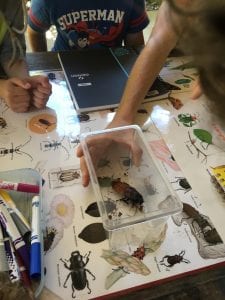Hello Earth Friends STEM!
We had a great week exploring the differences between insects and arachnids! An insect has three body segments: the head, thorax and abdomen. An arachnid has two body segments: the abdomen and cephalothorax. Arachnids have eight legs; Insects have six legs. Insects have compound eyes; arachnids have simple eyes. We had a chance to observe 3 types of insects up close. The praying mantis, millipede, and Madagascar hissing cockroach are from our collection here at Irvine. The students were able to count the legs and body segments. It was also a great chance to talk about specific defense mechanisms that invertebrates employ to survive; camouflage, flight, burrowing, chemical deterrents, spikes etc.
- Madagascar Hissing Cockroach
- North American Millipede
After looking at many examples of insects, we hiked on the trails to the meadow in search of as many insects as we could find! We checked under decaying logs and in tall grasses and had success in the meadow; crickets and grasshoppers were found. We also had a chance to play with all of the milk weed in the meadow. The kids had a blast throwing large handfuls of fluffy seeds up into the air!
We finished the day with a science experiment. We explored the process of Chromatography! Chromatography is a technique used to separate a chemical into its individual parts; normally by passing it through a liquid. Different colored markers are made up of many different colors, especially the darker colors such as brown and black.
We had a couple questions that we wanted to answer by the end of the experiment. What did you think was going to happen? How many colors did you see on your filter? Is there a type of marker that worked best?
The Process: Students made a dark ring of colored marker on a coffee filter. The filter was then folded in half twice. The tip of the cone is place in a cup of water. As the water travels up the filter, is disperses the colors of that marker throughout. We allowed the filters to dry. Since we had studied insects all day, we turned our chromatography dyed filters into a beautiful butterfly!
- Various stages of experiment
- Finished chromatography butterfly!






